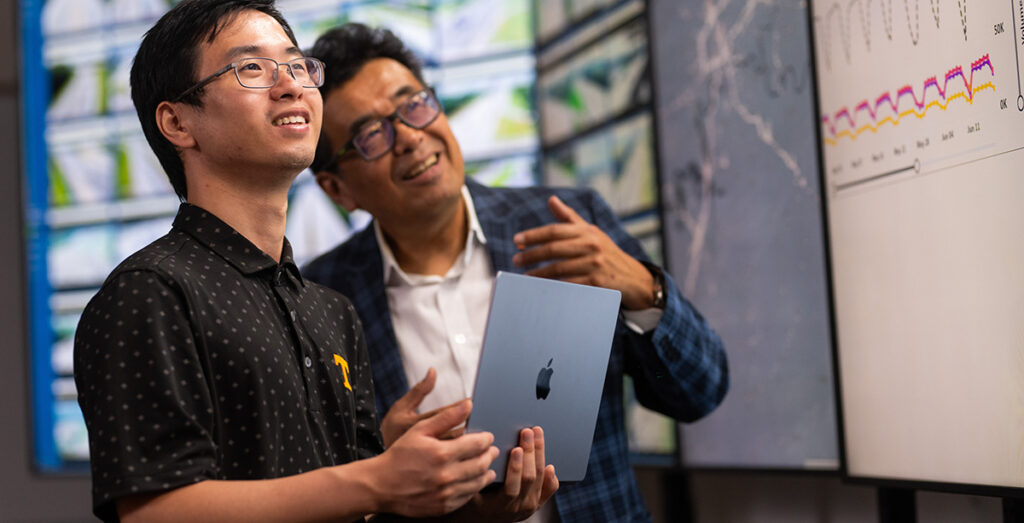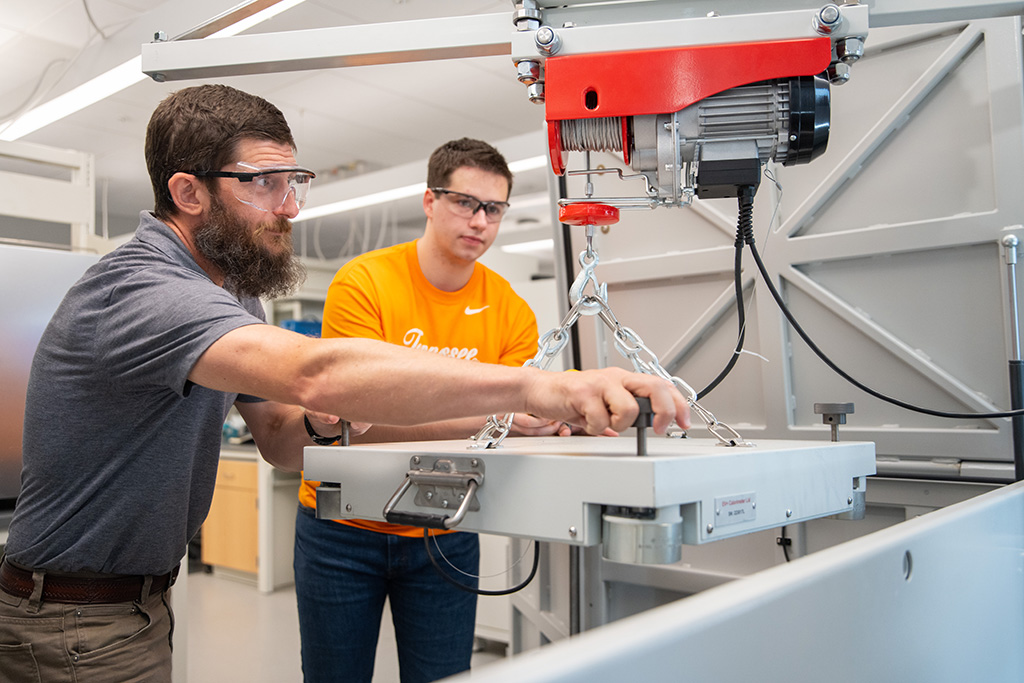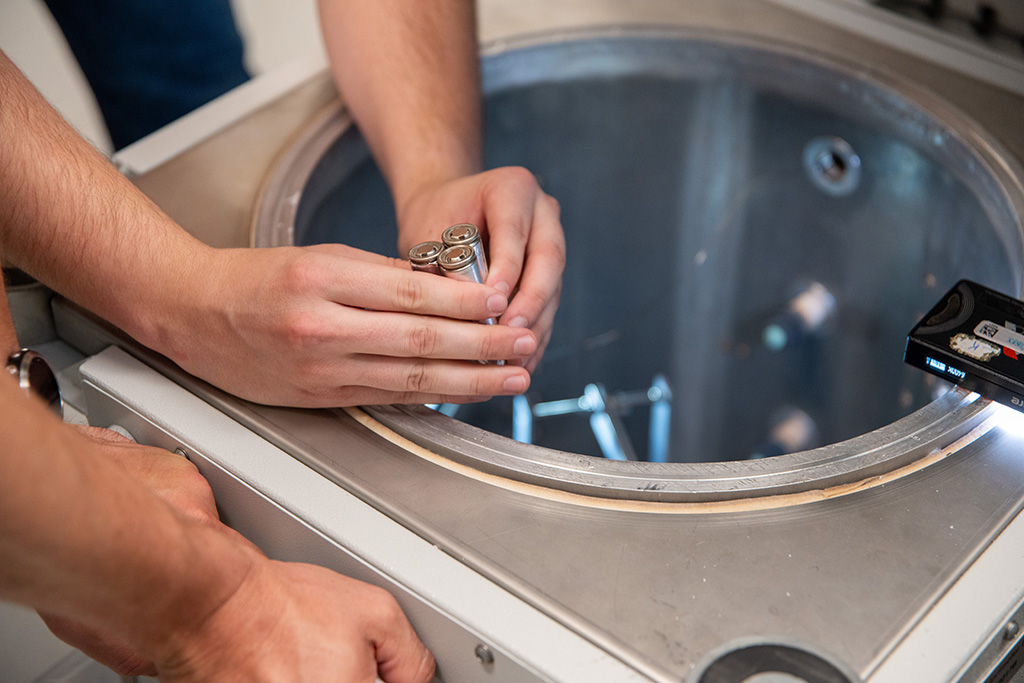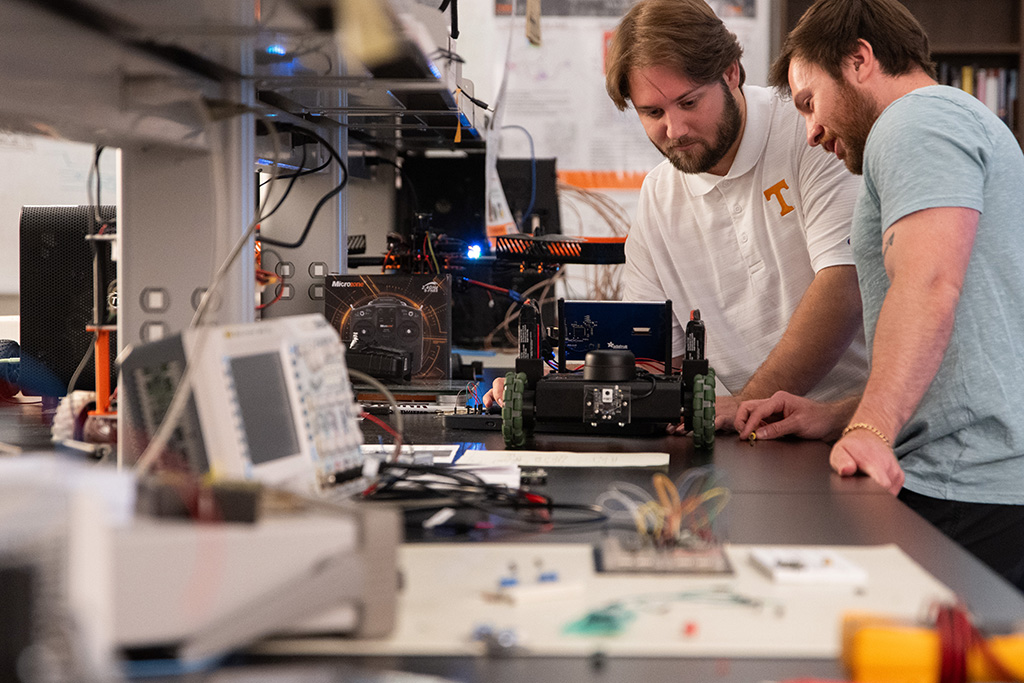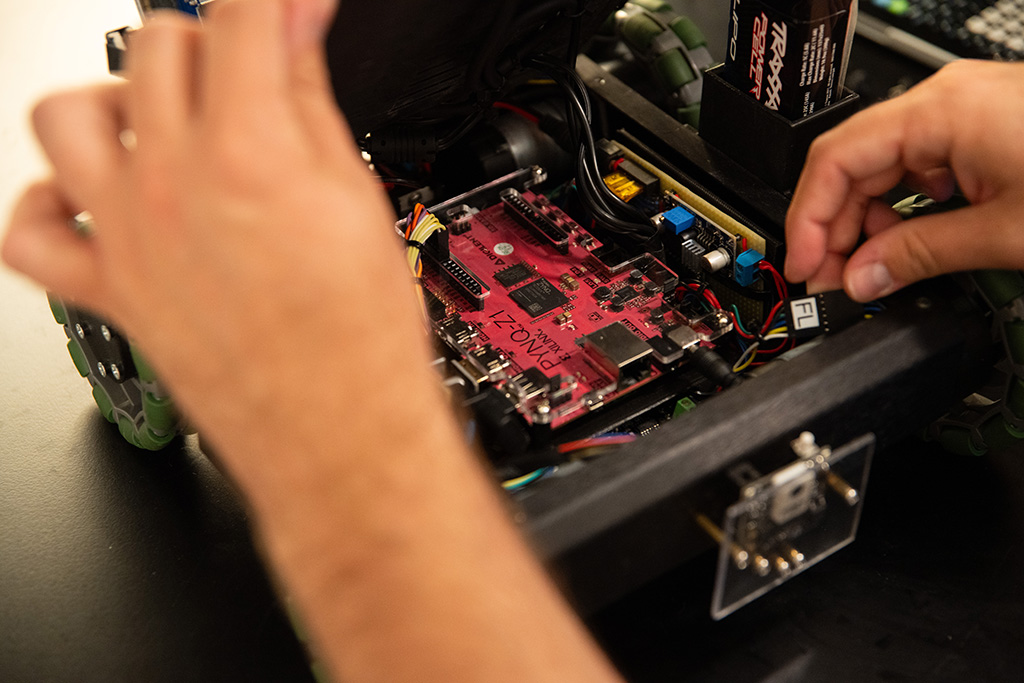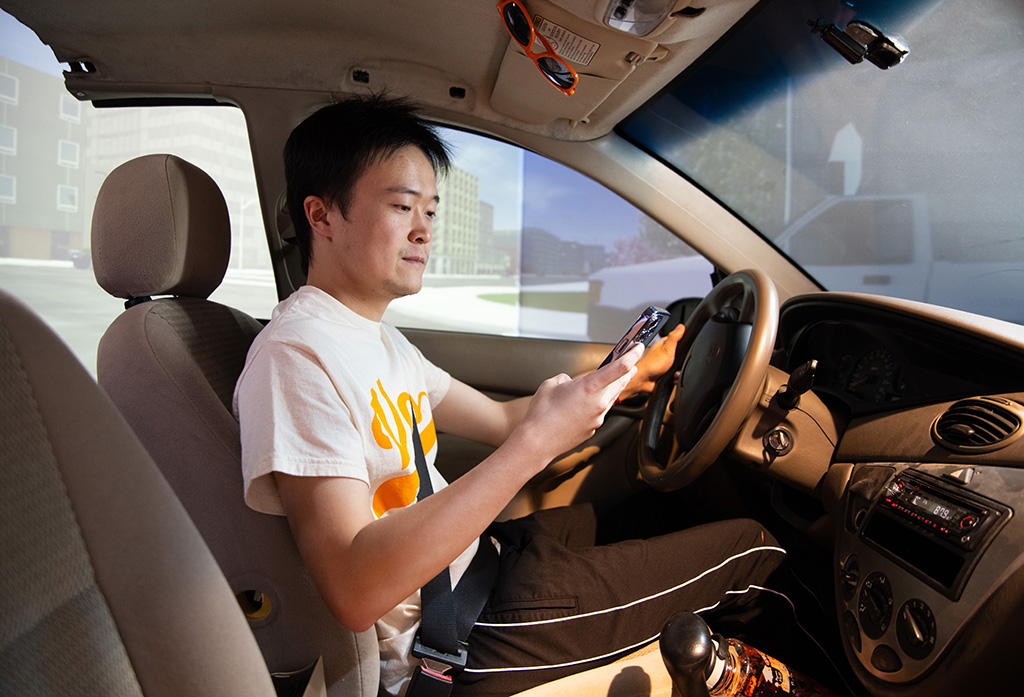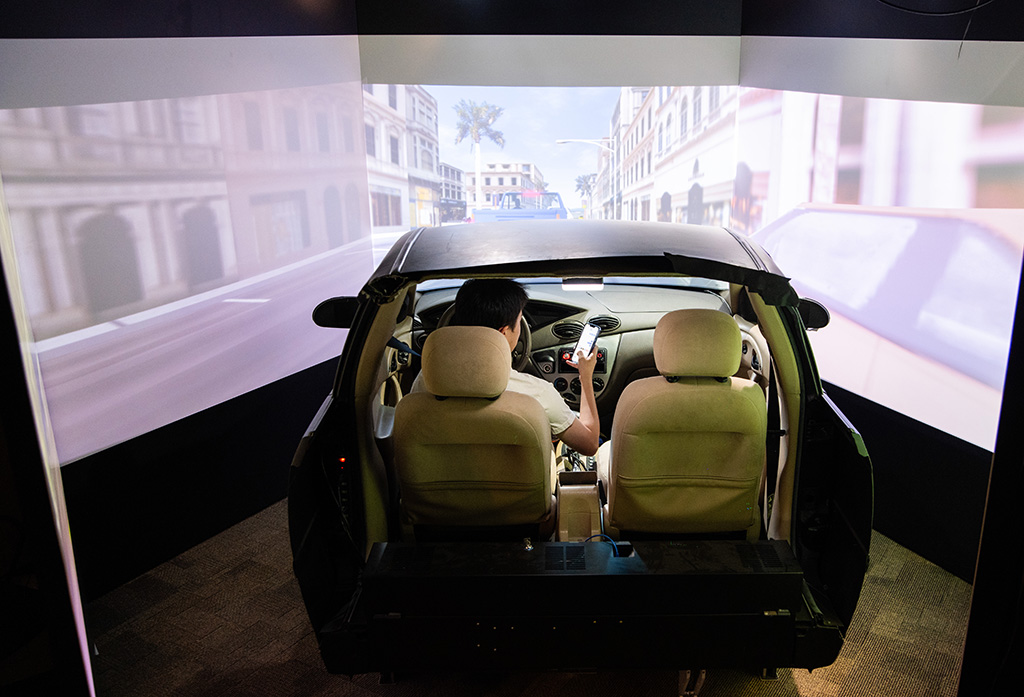Longer-lasting batteries and lighter-weight vehicles. Wireless charging stations and sustainable materials. More efficient supply chains and more effective public policy.
UT researchers are at the forefront of the technology and societal forces that are revolutionizing transportation here in the United States and around the world.
By bringing together the university’s deep bench of expertise, the state’s robust manufacturing ecosystem, and the real-world experience of industry and other partners, UT has positioned itself as a leader in the future of mobility.
“We are at the cusp of a new era in how we move people and goods from one place to another, and that is creating opportunities to be part of the new mobility economy,” said Deb Crawford, UT’s vice chancellor for research, innovation, and economic development. “Our strengths in fields like advanced materials and manufacturing, artificial intelligence, and supply chain management combined with our mission as a flagship, land-grant university make UT an ideal partner in not just developing critical research but also training the future workforce and crafting the public policies we need.”
The future of mobility includes not only the technology shaping the next generation of vehicles—like electric charging and autonomous cars—but also how people and communities use transportation. That, too, is shifting with the evolution of ride-sharing services, remote work, and public infrastructure.
Approaching future mobility with a wider lens means bringing together experts from across disciplines and organizations. Partnerships with industry, government, and other colleges and universities are critical to success.
The race among states is on to attract the next generation of automotive employers and investors in electric vehicle research and development and to leverage advances in automation to better serve individuals, communities, and organizations. In Tennessee, there are currently more than 900 companies in the automotive manufacturing sector that employ about 140,000 workers.
”UT is in a unique position to bring together world-class research, workforce development, community engagement, and partnerships with industry,” said Kevin Heaslip, director of UT’s Center for Transportation Research and head of the new Institute for Future Mobility. “Our faculty and students are solving real-world industry problems and meeting real people’s needs. We’re steadily deepening the world’s understanding of the science behind better mobility and commercializing new technologies to help make it safer, cleaner, and more efficient and affordable.”
The Institute for Future Mobility launched in September and connects industry and community partners with UT researchers representing engineering, computer science, agriculture, chemistry, social work, economics, public policy, supply chain management, and other fields. It also builds on multi-university national initiatives that reach beyond UT, such as the US Department of Transportation-funded Center for Freight Transportation for Efficient and Resilient Supply Chain and TEAM TN, a first-of-its-kind statewide mobility coalition funded by the National Science Foundation.
TEAM TN is a coalition of more than 100 organizations, led by UT and representing industry, community, economic development, and higher education organizations—including technical and community colleges as well as four-year universities. TEAM TN will develop and commercialize new technologies, attract new businesses and research investments to the state, and prepare Tennesseans for well-paying jobs in the mobility sector. This initiative aims to put the entire state of Tennessee at the cutting edge of the mobility revolution and win a larger share of the future mobility market, estimated at $2 trillion by 2030.
Initiatives like the Institute for Future Mobility and TEAM TN are fueling the university’s research and its visibility, leading more partners to turn to UT experts for help addressing challenges.
UT’s mobility research advances solutions in three primary areas: decarbonization, digitization, and societal mobility. By approaching their research with an eye toward industry and the research needs of our partners, UT’s faculty and graduate students are able to tailor their work to meet the challenges that matter most in the real world.
“This is how we create the most meaningful impact—locally and globally,” Heaslip said.
Decarbonization: Creating a Clean and Powerful Future
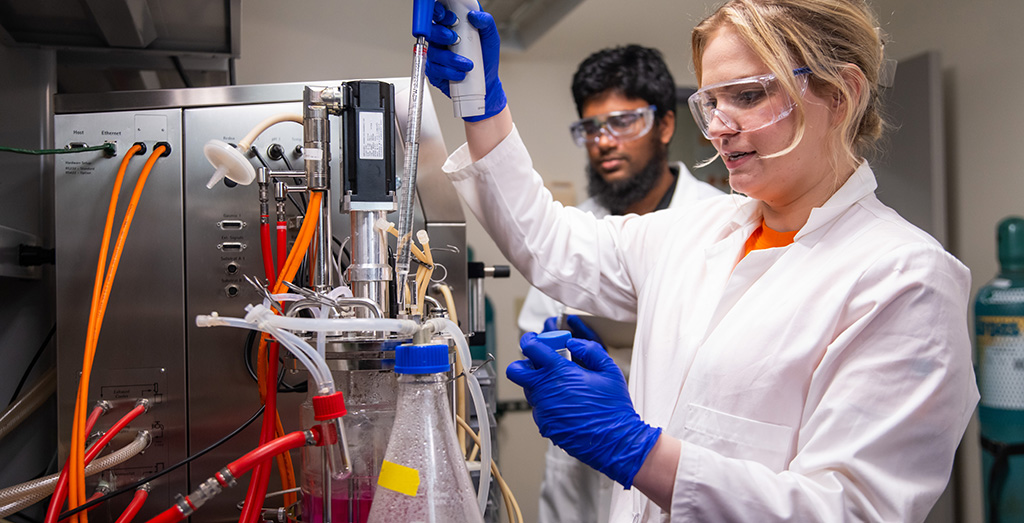
PhD student Carrie Sanford conducts an experiment in the bioreactor room in Senter Hall as Galib Hassan Khan, also a graduate student, observes.
The transportation sector is one of the largest contributors to greenhouse gas emissions in the country, and tailpipe emission pollutants directly affect human health. Investors, companies, and consumers alike are seeking sustainable transportation options. UT researchers see immense potential to create positive change by developing low-carbon alternatives to fossil fuels and driving the shift to zero-emission electric motors. Ultimately, the goal for alternative fuels and electrification is to create cost-competitive solutions that shrink transportation’s environmental footprint while simultaneously improving vehicle performance and the experience of the consumer.
UT research focuses not only on personal vehicles but also heavy-duty trucks, trains, ships, and planes. It spans hydrogen fuel cells and hydrogen combustion; biofuels derived from wood and fast-growing nonwoody plants; batteries; and the power electronics that are essential to modern vehicles.
“Petroleum, which takes millions of years to make, has a negative impact on the environment and the air we breathe,” said Nicole Labbé, biomass chemistry professor and assistant director of the Center for Renewable Carbon. Labbé and Biosystems Engineering and Soil Science Associate Professor Nourredine Abdoulmoumine are instead pursuing biofuels for aviation. “Derived from plants, biofuels create a circular system that minimizes transportation’s impact,” Labbé said.
Burning petroleum releases carbon dioxide previously trapped inside the earth into the atmosphere. Biofuels, however, create a loop in which carbon dioxide in the atmosphere is absorbed by growing plants; some amount of that carbon is released when the biofuels are used; then carbon is reabsorbed by new plants.
The amount of carbon that can be removed from the atmosphere depends on many factors, including plant species, farming practices for growing the plants, supply chain logistics, and technologies for creating the biofuels. Labbé and Abdoulmoumine research how to improve biofuel production at each of these stages. Their team recently earned funding from the US Department of Energy to investigate how Southeastern farmers can grow biofuel plants in more economically and environmentally beneficial ways.
Fuel and electrification research go hand in hand: alternative fuels are a bridge to the eventual large-scale shift to electrification, and they will continue to provide viable options for some modes of transportation far into the future. High-performance fuel cells, for example, currently show more promise than batteries for sustainable long-haul trucking. UT participates in the Department of Energy’s Million Mile Fuel Cell Truck Consortium to increase fuel cell durability, providing a longer-lasting energy source and lower cost of ownership for owner-drivers.
- Doug Aaron, left, and graduate student Preston Young use the Accelerating Rate Calorimeter.
- The Accelerating Rate Calorimeter tests thermal runaway of lithium-ion batteries.
When it comes to electrification, UT faculty are advancing technologies that make EVs more attractive to more users. They’re helping to increase battery range, make charging more convenient, and decrease users’ overall energy consumption over time. Electric power and propulsion for automobiles and aircraft require several types of technology, including chargers, batteries, electric motors, and power converters.
In the past, commercially available semiconductors for vehicle power electronics were made almost exclusively from silicon. Now, electrical engineering Associate Professors Daniel Costinett and Hua “Kevin” Bai are helping advance a different class of semiconductors called wide bandgap (WBG). WBG devices are made with gallium nitride (GaN) or, more often for EVs, silicon carbide (SiC). They’re faster and more efficient than traditional semiconductors, and they enable the components around them to be lighter, smaller, and more efficient.
“Compared to silicon, a WBG motor drive gives you a greater driving range on the same battery or lets you use a smaller battery for the same distance,” Bai said. WBG is also accelerating the development of technologies like extreme fast charging and wireless power transfer for wider adoption.
“However, WBG requires different circuit designs to leverage its benefits,” Costinett said.
Bai and Costinett are faculty with PoTENNtial, a graduate traineeship program that hones students’ expertise in researching and designing WBG semiconductors for power electronics. PoTENNtial is led by UT in collaboration with Oak Ridge National Laboratory and CURENT, and in partnership with leading power electronics and vehicle manufacturers.
Digitization: Improving Vehicle Connection and Computation
- Graduate students Adam Foshie and Charles Rizzo work on GRANT (Ground Roaming Autonomous Neuromorphic Targeter)
- Hardware inside GRANT
Today’s new cars already use some automated features, like adaptive cruise control and lane assist. Progress in fully automating vehicles—making them self-driving—continues to accelerate.
UT faculty and students are developing communications and computational technologies to enable connected automated vehicles (CAV) to observe the world through cameras, sensors, and GPS; share real-time information with other vehicles; communicate with smart infrastructure like traffic lights and pedestrian walkways; and take effective actions in response to real-time data.
Researchers envision a future their work is helping to shape: people in and around vehicles will be safer, traffic jams will be a problem of the past, vehicles will run more efficiently, and goods will be shipped more efficiently. To bring this vision to life, multidisciplinary collaboration is essential. Experts in 5G+ wireless communication technology, cybersecurity, and machine learning, for example, build on one another’s work. Mechanical engineers partner with computer vision experts, while relying on civil engineers to analyze traffic accident data. Together, they’re making sure future vehicles can generate, analyze, and act on the right data—rapidly, reliably, and safely.
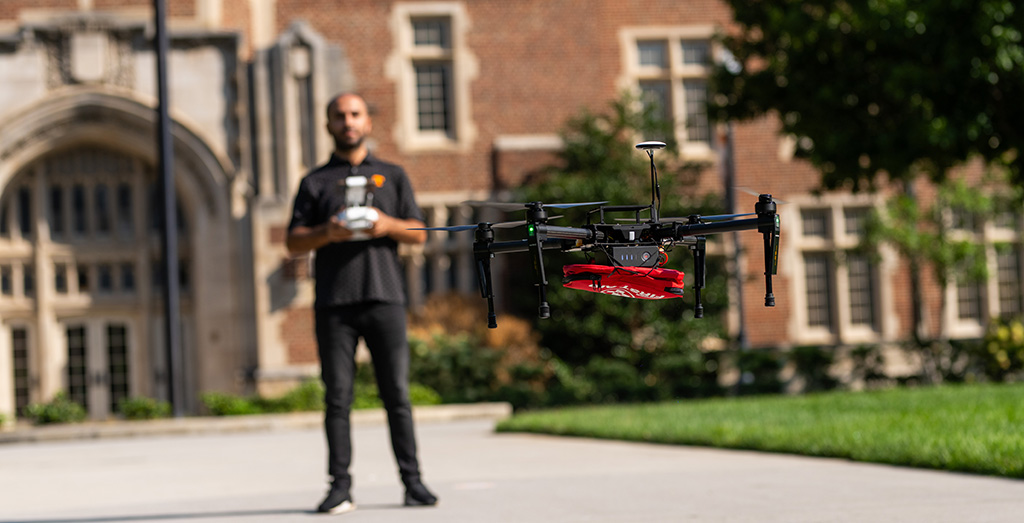
Sabrullah Deniz prepares for drone delivery of a first-aid package on the lawn in front of Ayres Hall
Assistant Professor Subhadeep Chakraborty from UT’s Tickle College of Engineering is advancing human safety in and around CAVs. “If you change one factor around the vehicle, what counts as safe or unsafe behavior changes,” he said. “So we are defining safety bounds for vehicles that are tuned to the level of the vehicle’s automation, the driver’s responses, and different weather and other environmental conditions.”
Testing vehicle automation systems on the road can be both expensive and dangerous. Mechanical engineering PhD student Joe Beck and other members of Chakraborty’s group have developed an innovative testing process. Beck designs virtual simulations of various driving scenarios and feeds them into an actual car’s processing hardware. The vehicle responds as if it were receiving input from real cameras and sensors—accelerating, turning, and braking while safely lifted on rollers with a chassis dynamometer.
“We can change one factor at a time. I can have the same pedestrian walk in front of the car, but with the sun at different angles to see how the camera vision registers glare,” Chakraborty said. “It’s unique to have this kind of control, and it’s safe for everyone involved.”
Societal Mobility: Driving Opportunities
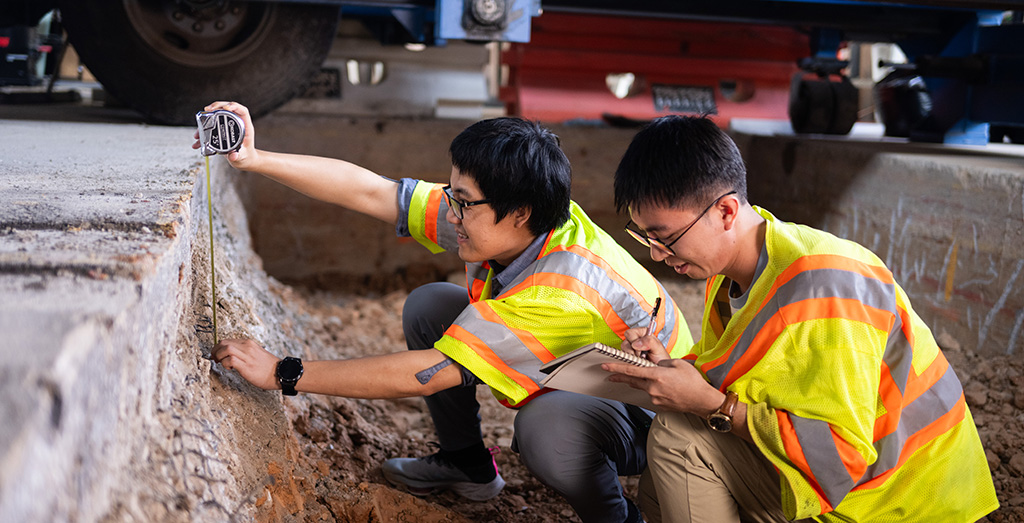
Graduate student Jingtao Zhong measures the layers in an experimental road surface while Assistant Research Professor Yuetan Ma observes and records data
Mobility doesn’t happen in a vacuum. Infrastructure design and maintenance, transportation policies, economic incentives, human behaviors, socioeconomic factors, cultural trends, and climate change are all among the factors that influence how well mobility works for different people.
UT researchers are studying how people and goods move today and pursuing ways to strengthen the systems and structures that can make better mobility possible in the future. Faculty engage in these topics from across the Howard H. Baker Jr. School of Public Policy and Public Affairs, the College of Arts and Sciences, the College of Social Work, the Haslam College of Business, the Tickle College of Engineering, and the UT Institute of Agriculture. Their investigations cover urban, suburban, and rural areas.
Some researchers focus on micromobility, public transit, and equitable transportation access. They examine human behaviors and the impacts of new technologies and policies. UT economists and engineers frequently advise national and state government agencies in developing transportation policies, understanding policy impacts, and financing infrastructure priorities.
Assistant Professor Ben Leard, in the Department of Agricultural and Resource Economics, focuses his attention on the intersection of domestic transportation and climate policies. He uses economic modeling and analysis to determine the costs and benefits of policy changes, including upcoming changes to the federal fuel economy standards for new vehicles.
Leard also generates insights to inform such policy changes by studying consumers’ vehicle purchase demand and the drivers behind their vehicle choices. Most recently, his work involves estimating future consumer demand for new vehicles and specific types of vehicles. His findings have implications for both the fuel efficiency standards and policies intended to increase EV adoption.
Other researchers focus on improving the freight transportation that keeps America’s economy rolling. US annual freight volume is expected to double in value between 2020 and 2050. At the same time, drivers are retiring and not being replaced. More frequent extreme weather events disrupt supply chains. And freight accounts for almost 10 percent of US greenhouse gas emissions. UT is tackling challenges from many angles through the Transportation and Logistics Collaborative and the Center for Freight Transportation for Efficient and Resilient Supply Chain, a multi-institutional consortium funded by the US Department of Transportation.
By addressing real-world problems for communities and corporations alike, faculty, staff, and students are helping remove barriers to and create new opportunities for personal well-being, economic opportunity, and environmental sustainability.
“Transportation intersects with so many aspects of life,” said Professor Courtney Cronley in the College of Social Work. “Especially when you can’t access it.”
Cronley’s research reveals “latent demand” for transportation—the trips that people would have taken…if the bus had run on time, if the car hadn’t broken down, if someone could have picked them up. “Most transportation modeling for future improvements is based on trips people actually take. It’s hard to model for equity when the data doesn’t represent current inequities,” she said.
As part of a multi-institutional, interdisciplinary team, Cronley helped develop an app that captures latent demand and the impacts of untaken trips on people’s physical, mental, and economic well-being. Now, Cronley is combining her expertise with engineering faculty Candace Brakewood’s research in public transit ridership and Chris Cherry’s in micromobility to understand and address latent demand here in Knoxville. “We are investigating ways to increase mobility options in our underserved communities and how to link increased mobility to physical health while helping involve these areas in the larger transition to a sustainable transportation system,” Cronley said.
Prepared for Life
Through all this research, both graduate and undergraduate students are involved in asking questions, engaging partners, and developing new technologies. They have access to state-of-the-art facilities on and off UT’s campus, and they learn from world-class researchers not only at UT but also at Oak Ridge National Laboratory and other partner organizations. As every faculty member points out, government and industry partners bring their real-world problems to solve—giving students opportunities to build skills, experience, and most importantly, to help develop real-world solutions.
“When our students graduate, they already understand their future employer’s biggest problems and the cutting-edge solutions to those problems,” Heaslip said. “They’re ready to make their mark on the company they choose.”
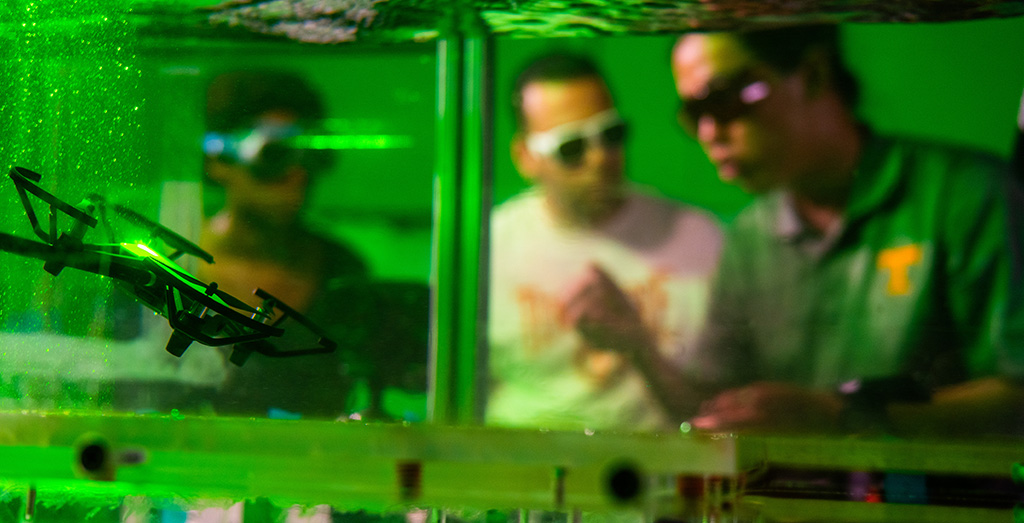
Assistant Professor Haochen Li and students Leila Kelly and Mohamed Shatarah use a flume to better understand the performance of drones in wind
“I believe the real-world impact of my research will be clear in the very near future,” Beck said. “Car manufacturers need a cost-effective platform to develop [self-driving] systems. But perhaps more importantly, regulators will need platforms for validation. Using vehicle simulation platforms to both discover common failure scenarios and validate against them will be critical for public trust and safety as vehicle automation continues to expand.”
“I give students like Beck the overview and goal,” said Chakraborty, who serves as Beck’s advisor. “Then they do so much with that! These students are preparing to lead any organization in the world.”
The Office of Undergraduate Research and Fellowships, part of UT’s Division of Student Success, helps undergraduates get involved through internships, co-ops, and experiential learning. Graduate students pursue research opportunities through traditional graduate research assistantships and other programs.
- Graduate student Hairuilong Zhang demonstrates the impact of driving while distracted in the Driving Simulator Lab
Hairuilong Zhang is a PhD candidate in the Bredesen Center’s interdisciplinary Data Science and Engineering program. “By using data and technologies, we have the opportunity to make transportation systems more efficient, reduce congestion, lower emissions, and enhance accessibility for all,” he said. One way he’s doing this is by using artificial intelligence (AI) to develop smart traffic management systems that monitor highway traffic and respond to incidents in real-time.
Zhang values the Bredesen Center’s interdisciplinary approach and unique opportunities to collaborate and network with students, faculty, and professionals from many backgrounds. “In transportation research, it’s important to consider not only the engineering aspects but also the social, economic, and environmental factors that impact mobility.” The Bredesen Center program facilitates this.
Zhang encourages others to learn about the program: “If you’re passionate about making a meaningful impact, gaining a wide range of data science skills, and preparing for a career at the forefront of innovation, this program could be an excellent choice.”
Graduate student fellowships are a key element of UT’s partnership with Volkswagen Group of America, Inc. Whether the students plan to remain in academia or enter industry, they jump-start their careers as they tackle a wide range of scientific and business challenges. Since 2020, fellows have pursued a variety of research interests, including advancing fiber-reinforced plastics and new, lower-carbon materials that are recyclable or reusable. Others have investigated how the shapes materials are in will affect performance in a car crash and explored new technologies like EV wireless charging. This fall, Volkswagen plans to expand the number of fellowships offered to grad students, as well as undergraduate internships.
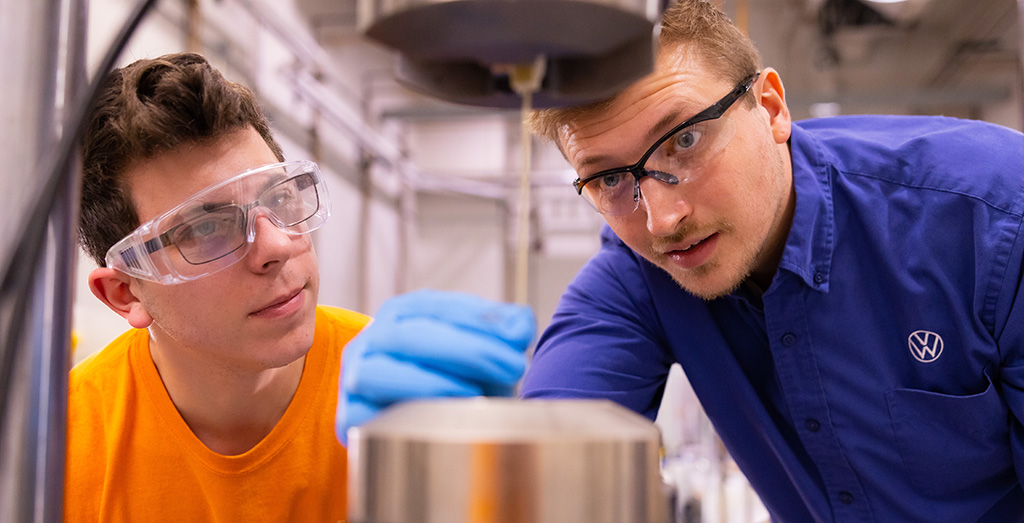
William Henken, a Volkswagen Doctoral Fellow, demonstrates tensile testing of glass fiber reinforced polymeric composites in a lab
UT and Volkswagen Group of America’s partnership reaches back to 2011. In 2020, this partnership evolved into an extraordinary new opportunity for both the university and the company: the Volkswagen North American Innovation Hub at the UT Research Park at Cherokee Farm. This location is the center point for joint research projects, student engagement, and collaboration with ORNL scientists. Research within the hub is focused on light-weighting structures, developing new sustainable materials, and advancing electric mobility. The benefits of the hub continue to expand, as does Volkswagen’s involvement in building Tennessee’s innovation ecosystem—Volkswagen is now also a partner in the TEAM TN collaboration. In October, UT and Volkswagen announced the signing of a new five-year master research agreement, extending their longstanding and productive partnership.
Providing industry-informed hands-on experiences like these within the context of STEM undergraduate and graduate degree programs is critical for Tennessee’s long-term leadership in the mobility industry. Equally important are technical apprenticeships and programs that reskill and upskill Tennesseans for high-demand jobs. Workforce development objectives are embedded into many UT mobility research projects. Funded projects often encourage collaborations with local community colleges and workforce development organizations. Workforce development is one of the four core pillars of TEAM TN, for example.
Sociology Professors Stephanie Bohon and Jon Shefner and the Center for Transportation Research have secured the first of three phased grants from the national nonprofit Jobs for the Future.
During this first phase of the nonprofit’s Quality Green Jobs Regional Challenge, UT is leading 60 area partners in laying the groundwork for a regional green jobs initiative. The initiative will be designed to connect more workers with the right vocational training to land high-quality jobs related to sustainable transportation and other green technology and manufacturing sectors.
Powering Progress and Benefits
“We’re at the right place, at the right time, with the right people and partners for UT to lead on future mobility,” Heaslip said. Students, workers, corporate partners, and neighbors right here in Knoxville all stand to benefit. “There’s something for everyone,” he adds. “Cleaner air. Better access to health care and jobs. Safer roads. Economic and workforce development. Tennessee becoming a richer innovation ecosystem.” UT research is powering progress in all of these directions.
